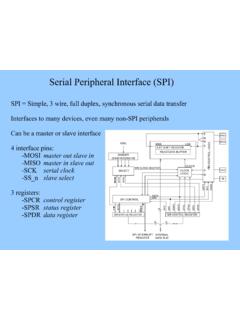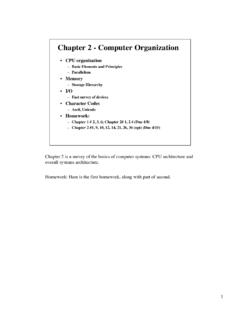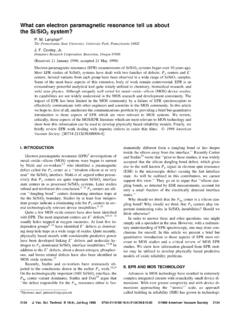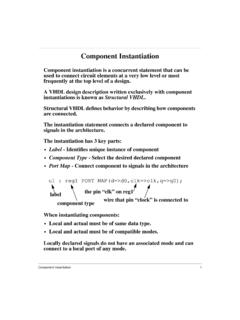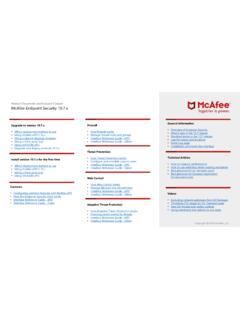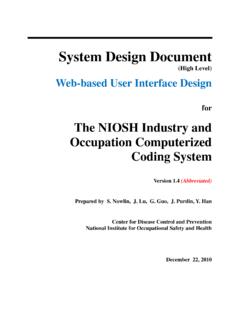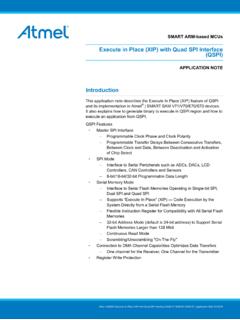Transcription of Serial Peripheral Interface (SPI) - College of Engineering
1 Serial Peripheral Interface (SPI)SPI = Simple, 3 wire, full duplex, synchronous Serial data transferInterfaces to many devices, even many non-SPI peripheralsCan be a master or slave interface4 Interface pins:-MOSI master out slave in-MISO master in slave out-SCK Serial clock-SS_n slave select3 registers:-SPCR control register-SPSR status register-SPDR data registerSerial Peripheral Interface (SPI)Full duplex, synchronous Serial data transferData is shifted out of the master's (mega128) MOSI pin and in it's MISO pinData transfer is initiated by simply writing data to the SPI data data movement is coordinated by SCK. Slave select may or may not be used depending on interfacing get input data only you send junk data to SPDR to start the SPI devicemaster SPI deviceSerial Peripheral Interface (SPI)Slave use it carefully!In master mode:-SPI Interface has no control of SS_n-User software has full control of SS_n (Port B, bit 0)-If configured as output, it s a general purpose output-If configured as input, it must be held high, else you will enter slave modeWe will use SPI in master mode, full duplexSerial Peripheral Interface (SPI)SPI Control Register (SPCR)data order: if set, LSB istransmitted firstinterrupt enable: if set, interruptoccurs when SPI interrupt flag and global interrupt enable are setspi enable: if set, SPI interfaceis enabledmaster/slave select: if set,SPI in master modeclock polarity:'0' SCK low in idle'1' SCK high in idle clock phase.
2 '0' leading edge sample, trailing edge setup'1' leading edge setup, trailing edge sample clock rateSPI2X SPR1 SPR0 SCLK 0 0 0 fosc/4 0 0 1 fosc/16 0 1 0 fosc/64 0 1 1 fosc/128 1 0 0 fosc/2 1 0 1 fosc/8 1 1 0 fosc/32 1 1 1 fosc/64(in SPSR) Serial Peripheral Interface (SPI)SPI Status Register (SPSR)interrupt flag: set when serialtransfer is completewrite collision: set if SPDR iswritten during a receive transfer2x clock rate: if set, doublesclock rate in master modereserved bitsSPI Data Register (SPDR)SPDR is a read/write register used for data transfer. Writing SPDR sends dataout MOSI. Reading SPDR gets the data that was clocked into Peripheral Interface (SPI)Mega128 LCD interfaceSCK, PB1 LCD strobe, PF3 MOSI, PB2enable pulse generator9-bit shift registerSerial Peripheral Interface (SPI)SPI Application - Code/**/// spi_init //Initializes the SPI port on the mega128.
3 Does not do any further //external device specific initializations. /**/void spi_init(void){ DDRB = 0x07; //Turn on SS, MOSI, SCLK (SS is output) SPCR = (1<<SPE) | (1<<MSTR); //SPI enabled, master, low polarity, MSB 1st SPSR = (1<<SPI2X); //run at i/o clock/2}//spi_init/**/// digi_pot_send //Sends command and data to the digital pot. SPI device chip select is //active low and is connected to port F bit 2. Total of 16 bits are byte for control and one byte as data passed in. /**/void digi_pot_send(uint8_t data){ PORTF //port F bit 2, assert active low SPDR = 0x13; //send command byte (fixed value) while (bit_is_clear(SPSR,SPIF)) {} //wait till data is sent out SPDR = data; //send data byte while (bit_is_clear(SPSR,SPIF)) {} //wait till data is sent out PORTF |= 0x04; //port F bit 2, deassert to logic high } //digi_pot_send Serial Peripheral Interface (SPI)Typical SPI IC (MCP42010) Serial Peripheral Interface (SPI)74HC595 A perfectly fine SPI peripheralSerial Peripheral Interface (SPI)What if you want only to read the SPI port?
4 To get the SPI clock to run, a "dummy" write is made to the SPISPDR register. This starts the clock running so the data on MISOis brought into the no peripherals are selected, the outgoing data will be ignored. If youare clever, you can send data out and bring data in at the same **/// spi_read //Reads the SPI port. /**/uint8_t spi_read(void){ SPDR = 0x00; //"dummy" write to SPDR while (bit_is_clear(SPSR,SPIF)){} //wait till 8 clock cycles are done return(SPDR); //return incoming data from SPDR }//read_spiSerial Peripheral Interface (SPI)74HC165 Another fine SPI peripheralSerial Peripheral Interface (SPI)SPI Gotchas Now my board won t program. SPI shares SCK with programming Interface . If it won t program anymore,you likely messed up SCK. SPI acts totally wierd. Often a symptom of SS_n being configured as an input and being left to floator allowed to go high.
5 SPI goes in and out between slave and master modes. I never get data to the SPI device. Is clock correctly oriented ? Did you assert the device chip select?(hint: put SPI write inside a tight loop and check with scope. WatchSCK, data, and chip select)"SPI device interactions:" When programming, the programmer first does a chip reset. When the mega128 resets, all pins are set to input with high impedance(floating). If a SPI device is on the SPI bus, its chip-select mayfloat low and enable the device, and SPI data will crash the programming data. Adding a pull-up resistor to chip selects will solve this problem.
